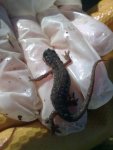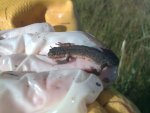jane1187
New member
I'm currently working on a relocation project involving the capture and relocation of smooth newts (in the UK). Recently we've been finding some smooth newts with 'lumpy' skin. This is obviously an illness of some sort since smooth newts do not have warty skin. The newts sometimes show jerky movement which also indicates that this may be an illness of some kind. The lumps distort the newt's body shape and do not exude any fluids of any kind. I've never seen a disease of this kind amongst my own pet newts and haven't seen this amongst wild newts either.
We have been reluctant to take these newts to the new site for fear that it is a contagious disease and we do not want to contaminate the new site.
I have attached a couple of photos of one of the more serious looking newts. You may be able to make out the lumps, some of which distort the face as well as the body.
Just incase it aids a disgnosis, the site is potentially chemically contaminated which is why the current verdict is chemical burns. However so far the sick newts found have been randomly spread around the large site which would suggest that a chemical on the ground is not to blame. We also use carpet tiles which may have chemical dyes on them or such like, could they cause an issue? Perhaps it is a commonly occurring disease in wild newts (or amongst pet newts) that someone recognises?
Even if you can't suggest a particular disease please post suggestions as to what my be the cause of these strange lumpy newts so that we can act appropriately during our relocation efforts.
We have been reluctant to take these newts to the new site for fear that it is a contagious disease and we do not want to contaminate the new site.
I have attached a couple of photos of one of the more serious looking newts. You may be able to make out the lumps, some of which distort the face as well as the body.
Just incase it aids a disgnosis, the site is potentially chemically contaminated which is why the current verdict is chemical burns. However so far the sick newts found have been randomly spread around the large site which would suggest that a chemical on the ground is not to blame. We also use carpet tiles which may have chemical dyes on them or such like, could they cause an issue? Perhaps it is a commonly occurring disease in wild newts (or amongst pet newts) that someone recognises?
Even if you can't suggest a particular disease please post suggestions as to what my be the cause of these strange lumpy newts so that we can act appropriately during our relocation efforts.


